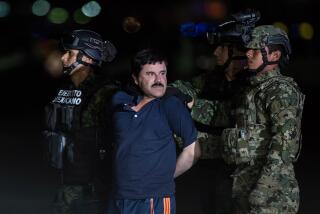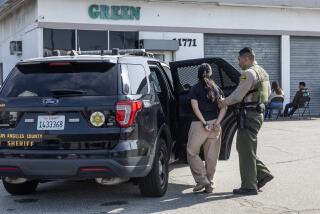Reluctant U.S. Military Marches to Drug Wars : Carlucci, Pentagon Officials Say Effort Will Cost Too Much, Yield Too Little, Peril Civil Liberties
- Share via
TINKER AIR FORCE BASE, Okla. — A half-dozen huge AWACS radar surveillance planes sit on the ramp here, unlikely and colossally expensive weapons in the nation’s war on drugs.
Designed to detect intruding enemy aircraft and direct American fighters to shoot them out of the sky, the $130-million E-3 AWACS, with its ungainly 30-foot radar dome, is being used today to track drug smugglers in slow, low-flying Cessnas and Pipers.
Operating the AWACS (airborne warning and control system) costs about $9,000 an hour, and the plane’s success in catching drug runners has been meager. AWACS crews flew 3,983 hours on drug-interdiction missions last year at a cost of about $35 million. The result: two drug busts.
So far this year, the Air Force has flown about 300 AWACS drug-spotting sorties and has caught zero dope smugglers, according to Tinker officials.
Mission Mismatch
The mismatch between mission and machine symbolizes the problem confronting the U.S. military as a zealous Congress prepares to greatly broaden the Pentagon’s role in the battle against illegal drugs.
Pentagon officials from Defense Secretary Frank C. Carlucci on down have not tried to hide their distaste for the job, saying that it will cost too much, yield too little, divert soldiers and equipment from their primary mission and pose serious civil liberties problems.
A nation maintains armed forces to deter war, or fight one if deterrence fails, Carlucci argues. Soldiers, he says, cannot and should not be turned overnight into drug cops.
“Our military is not trained to read people their Miranda rights,” Carlucci told Congress two weeks ago. “They’re trained to shoot to kill.”
Nor is most military equipment designed for the kind of police work involved in stopping drug smugglers, Pentagon officials contend.
“The only way that an F-16 is really prepared to deal with a Cessna flying across our border is to shoot it down,” said Defense Department spokesman Dan Howard. “The first time we shoot down a dentist flying back from Key West in his Cessna who doesn’t have the right radio equipment on board, then we will have another problem.”
But the politicians, driven by strong public anti-drug sentiment less than six months from the November elections, insist that the current agencies on the front lines of the drug war--the Coast Guard, the Customs Service, the Drug Enforcement Administration--are out-manned and outgunned by the druggies. It’s time, they say, to call out the Army, Navy, Air Force and Marines.
“The military is still our first line of defense,” said Sen. Pete Wilson (R-Calif.), co-sponsor of Senate legislation to involve the military more deeply in the narcotics war. “Drugs are a greater threat to our national security than anything else, even the Soviets.”
The Senate’s instructions to the Pentagon, part of the 1989 defense spending bill that the Senate adopted Friday, call for the military to step up its drug surveillance and interdiction efforts and gives the Navy limited powers of arrest on the high seas. Drafted in consultation with Carlucci and other top military officials, the provision would cost an estimated $2 billion a year or more.
That is much less ambitious than a House measure, attached to the House-passed version of the defense-spending bill, that would require the Defense Department to “substantially halt” the flow of drugs into the country within 45 days by sealing the borders against drug smugglers.
The House version is strongly opposed by the Pentagon, which says that the job would entail enormous costs--$8 billion for equipment and $6 billion in annual operating expenses--and that it probably would fail.
The two measures will be debated in a House-Senate conference committee. The Senate version, with the support of the Reagan Administration and Senate Democratic and Republican leaders, appears likely to prevail.
Even that prospect concerns Air Force Col. James R. Sterk, commander of the 552nd AWACS Wing at Tinker Air Force Base. Although Sterk agrees that drugs are a critical national problem, he is not certain that he has the men, money or planes to fight drugs the way Congress wants him to.
“If I’m told to do a drug-interdiction mission, my answer is: ‘Yes, sir,’ and we go do it,” Sterk said in an interview last week. “But it requires substantially more resources to do what you’re asking us to do. Obviously, it won’t happen overnight. It’ll take more airplanes and more people to fly those airplanes.”
Like Sterk, the AWACS crews at Tinker are torn between a desire to do their part in the anti-drug effort and a soldier’s natural instinct to shun any duty that detracts from readiness to fight. But, on balance, the AWACS operators said that they would welcome a broader drug-interdiction mission because it would mean more flying hours for the radar plane’s 23-person crews.
“Every time we get our hands on the equipment, that’s a plus,” said Lt. Col. Edward K. Bucknell, an AWACS crew supervisor. “Everything we do (on a drug mission)--bringing up the systems, using the scopes, using the simulators--is applicable to our training requirements.”
On a typical drug-interdiction mission, an AWACS jet flying at 30,000 feet establishes an “orbit” that allows its radars to watch all air traffic along a 500-mile stretch of the U.S.-Mexican border or to scan the Florida coastline and almost the entire Caribbean. Tinker-based AWACS planes fly about 60 such nine-hour missions a month.
Members of a detachment of Customs Service officers based at Tinker often fly along on AWACS missions, sitting at one of the dozen radar consoles inside the plane and tracking small craft heading for U.S. borders. Sometimes they watch established smuggling routes for suspicious aircraft; at other times they track aircraft originating in Mexico, the Caribbean or South America that have not filed approved flight plans.
No Arrest Power
Suspicious aircraft are reported to Customs or Federal Aviation Administration officers on the ground, who decide whether to dispatch interceptors or stake out airfields where the planes might land. The Air Force cannot intercept or arrest drug smugglers because the century-old Posse Comitatus Act blocks the American military from domestic police functions.
The AWACS’ sophisticated radar can identify and track hundreds of aircraft at various speeds and altitudes. But sorting out the suspicious from the innocent is a formidable task and, judging from the results, one that the AWACS operators and their Customs Service colleagues have yet to master.
“A lot of it is based on us being in the right place at the right time,” said a Customs officer who often flies AWACS missions. “This is the sort of job where patience pays off.”
The Air Force last year spent $45.6 million on drug interdiction, most of it on AWACS missions, and caught only the two smugglers.
The Navy, which spent $37.4 million last year, realized a greater payoff. Sailing 2,512 ship-days last year with Coast Guard drug enforcement agents aboard, it seized 20 drug-carrying vessels and arrested 110 suspected smugglers, Coast Guard officials said.
The Army spent $8.3 million last year, much of it to fly 1,486 helicopter hours with Bahamian police on drug raids. Army officials said that they could not provide a number of arrests resulting from the program.
Beyond direct spending, the military last year lent equipment worth $303 million to other drug-fighting agencies--mostly aircraft for use by the Customs Service and the Coast Guard.
The wholesale price of cocaine at the point of entry provides dramatic evidence that the military has failed to stem the drug tide. In 1981, when the Reagan Administration took office and began the first concerted effort to stop drug smuggling at U.S. borders, the wholesale price of cocaine in Miami was $60,000 a kilogram. Today, according to federal law enforcement officials, a kilo of cocaine costs $10,000, and the supply is more plentiful than ever.
Peter Reuter, a RAND Corp. analyst who recently completed a Pentagon-funded study of the value of increased military involvement in drug-fighting efforts, said he concluded that drug-interdiction efforts are likely to fail because smugglers can always replace lost planes and boats and find new ways to penetrate the borders.
“Even if interdicters succeed in making smuggling riskier than it is now,” he said in an interview, “even that is not likely to make much difference to cocaine consumption.”
Reuter also noted a problem much discussed inside the Pentagon but little noticed outside--the potential, even the likelihood, that some military drug-fighters will be corrupted by the easy money to be gained by going over to the other side.
“Corruption has concerned every agency that has been involved in drug enforcement,” Reuter said. “The FBI, until the end of the 1970s, was extremely reluctant to get in drug enforcement because of the corruption potential.”
Sale of Secret Documents
He cited the 1983 case of Coast Guard helicopter pilot Derrick W. James, who stole government lists of boats suspected of drug activity and sold them to undercover officers posing as drug traffickers. James, who is serving a 10-year sentence for bribery and sale of secret government documents, said that he sold the papers to pay for a family trip to Walt Disney World.
Former Defense Secretary Caspar W. Weinberger, in a commentary published last week, said that involving the military in the drug wars would make for “terrible national security policy, poor politics and guaranteed failure.” He said it would inevitably turn American military weapons on American citizens, something this country properly has been loath to do.
“If military forces are turned against all our people--because in a sweeping effort such as Congress is considering, all must be suspect--discipline, esprit, morale and recruiting will suffer drastically,” Weinberger wrote.
Military commanders worry that drug missions will cut into their training time and equipment budgets. Army Gen. Fred F. Woerner, commander of the Panama-based Southern Command, recently complained to fellow officers that even without drug interdiction, he was overwhelmed with supporting the battle against an insurgency in El Salvador, trying to encourage democracy throughout Central America and protecting the Panama Canal.
An Army infantry officer summarized the military attitude this way: “The real philosophical issue is, can it be won? Do we want to pour the military into something that is fruitless and futile?
“We aren’t the solution to this problem; we don’t have military enough to solve this problem. Not because we’re not willing. But because this thing is very pervasive.”
More to Read
Sign up for Essential California
The most important California stories and recommendations in your inbox every morning.
You may occasionally receive promotional content from the Los Angeles Times.










